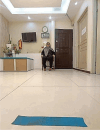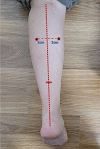Effect of dry needling plus static stretching on plantar flexor spasticity, function, and quality of life in a patient with chronic stroke: a case report
- PMID: 40383758
- PMCID: PMC12087024
- DOI: 10.1186/s13256-025-05270-7
Effect of dry needling plus static stretching on plantar flexor spasticity, function, and quality of life in a patient with chronic stroke: a case report
Abstract
Background: Static stretching is a treatment that reduces spasticity by elongating the muscle fibers. Dry needling is also a novel intervention that reduces spasticity by destroying dysfunctional endplates. Plantar flexor spasticity can cause gait disturbances and impaired balance in patients who have had a stroke. Therefore, reducing the spasticity of these muscles can improve the patient's independence and overall function. This study reported the additional effects of dry needling on static stretching in reducing spasticity and function in a chronic stroke patient.
Case presentation: The patient was a 47-year-old Iranian woman with a past-7-month history of stroke and plantar flexor muscle spasticity. In this study, interventions were conducted for 5 days. In the treatment session, first dry needling (60 seconds × 3 days/week for 1 week total) was applied on the gastrocnemius, and then, an orthosis was used for static stretching (20 minutes × 5 days/week for 1 week total). The outcome measures were the Modified Modified Ashworth Scale, active and passive range of motion, the timed up and go test, and the European Quality of Life questionnaire . The patient was assessed at baseline (T0), immediately following treatment (T1), and at 1-week follow-up (T2). The results were reported as follows: The Modified Modified Ashworth Scale score decreased from 2 at T0 to 1 at T1 and remained 1 at T2. Active range of motion increased from 10° at T0 to 25° at T1 and decreased again to 15° at T2. Passive range of motion increased from 40° at T0 to 50° at T1 and decreased again to 45° at T2. The timed up and go test decreased from 50 seconds at T0 to 40 seconds at T1 and increased again to 42 seconds at T2. Her European Quality of Life questionnaire score increased from 0.25 at T0 to 0.39 at T1 and remained unchanged at 0.39 at T2.
Conclusion: This case study reported a patient with post-stroke spasticity. After dry needling in combination with static stretching, spasticity and overall function improved. It would be beneficial to conduct a randomized clinical trial study with a control group to comprehend the additional impact of dry needling on static stretching. Trial registration IRCT20230719058844N1, Registered 7 August 2023, https://irct.behdasht.gov.ir/trial/71395 .
Keywords: Dry needling; Plantar flexors; Spasticity; Stretching; Stroke.
© 2025. The Author(s).
Conflict of interest statement
Declarations. Ethics approval and approval and consent to participate: Ethical approval for this study was obtained from the Ethics Committee of Tehran University of Medical Sciences (TUMS) under approval ID IR.TUMS.FNM.REC.1402.097. Consent for publication: Written informed consent was obtained from the patient for publication of this case report and accompanying images. A copy of the written consent is available for review by the Editor-in-Chief of this journal. Competing interests: The authors declare no conflict of interest.
Figures






Similar articles
-
Effect of Dry Needling Plus Static Stretching on Plantar Flexors Spasticity in Chronic Stroke Patients.J Acupunct Meridian Stud. 2024 Aug 31;17(4):141-148. doi: 10.51507/j.jams.2024.17.4.141. J Acupunct Meridian Stud. 2024. PMID: 39205617 Clinical Trial.
-
Effects of dry needling on spasticity, cortical excitability, and range of motion in a patient with multiple sclerosis: a case report.J Med Case Rep. 2024 Mar 24;18(1):125. doi: 10.1186/s13256-024-04452-z. J Med Case Rep. 2024. PMID: 38521912 Free PMC article.
-
The effect of dry needling on spasticity, gait and muscle architecture in patients with chronic stroke: A case series study.Top Stroke Rehabil. 2018 Jul;25(5):326-332. doi: 10.1080/10749357.2018.1460946. Epub 2018 Apr 23. Top Stroke Rehabil. 2018. PMID: 29683410
-
Dry needling for the management of spasticity, pain, and range of movement in adults after stroke: A systematic review.Complement Ther Med. 2020 Aug;52:102515. doi: 10.1016/j.ctim.2020.102515. Epub 2020 Jul 16. Complement Ther Med. 2020. PMID: 32951759
-
Effectiveness of static stretching positioning on post-stroke upper-limb spasticity and mobility: Systematic review with meta-analysis.Ann Phys Rehabil Med. 2019 Jul;62(4):274-282. doi: 10.1016/j.rehab.2018.11.004. Epub 2018 Dec 22. Ann Phys Rehabil Med. 2019. PMID: 30582986
References
-
- Whiteford HA, Degenhardt L, Rehm J, Baxter AJ, Ferrari AJ, Erskine HE, et al. Global burden of disease attributable to mental and substance use disorders: findings from the Global Burden of Disease Study 2010. Lancet. 2013;382(9904):1575–86. - PubMed
-
- Easton JD, Saver JL, Albers GW, Alberts MJ, Chaturvedi S, Feldmann E, et al. Definition and evaluation of transient ischemic attack: a scientific statement for healthcare professionals from the American Heart Association/American Stroke Association Stroke Council; Council on Cardiovascular Surgery and Anesthesia; Council on Cardiovascular Radiology and Intervention; Council on Cardiovascular Nursing; and the Interdisciplinary Council on Peripheral Vascular Disease: the American Academy of Neurology affirms the value of this statement as an educational tool for neurologists. Stroke. 2009;40(6):2276–93. - PubMed
-
- Mackay J, Mensah GA, Greenlund K. The atlas of heart disease and stroke: World Health Organization; 2004.
-
- Wissel J, Manack A, Brainin M. Toward an epidemiology of poststroke spasticity. Neurology. 2013;80(3 Supplement 2):S13-S9. - PubMed
Publication types
MeSH terms
Associated data
LinkOut - more resources
Full Text Sources
Medical
Miscellaneous

